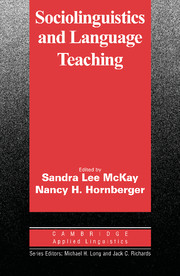Book contents
5 - Regional and social variation
Published online by Cambridge University Press: 22 July 2009
Summary
Introduction
“In the United States of America (or England, or India, or Australia), they speak English.” Although this statement is true, it is only a half truth, and understanding the other half of the truth is essential for any language arts teacher. Part of what this statement omits is that other languages besides English are spoken – Spanish, Gujerati, and Vietnamese, for instance – and that students' competence in and attitudes toward these languages, relative to English, can have a big impact on their success in and attitudes toward school. But part of what it omits is also that “English” is not a single entity but, like any other living language, something that varies considerably depending on one's regional background, social class and network, ethnicity, gender, age, and style, to name only the most salient dimensions. Understanding and recognizing such variation is essential for language arts and second and foreign language teachers.
Reasons for studying dialects
But “Why?” you might ask. One reason is to better prepare our students for the vernacular varieties of a foreign language which they can expect to find its native speakers using if and when they have the opportunity to travel abroad. Understanding the variability in our own language and that of our students is also very important for L1 and L2 teachers, because the regional and social dialects that teachers and children speak can have a big impact on students' success at school (see also Nichols, this volume).
- Type
- Chapter
- Information
- Sociolinguistics and Language Teaching , pp. 151 - 194Publisher: Cambridge University PressPrint publication year: 1995
- 2
- Cited by

